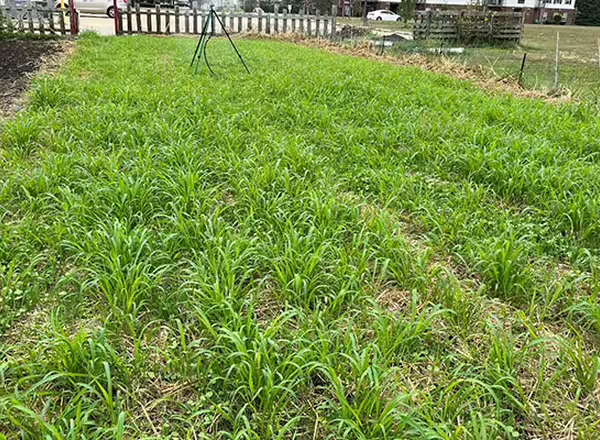
The ginger crop languished in the Unity high tunnel during August, putting on minimal growth — even with shade cloth in place of plastic over the top of the tunnel. The ginger trial team and I are starting to think that this crop may benefit from more than the 30% shade cloth we are using in the height of summer.
Even though it needs soil temperatures above 50º, it gets heat stress when ambient temperatures are 90º or more and can get sunburn too which turns leaf tips yellow or brown. The ginger rhizomes have taken off in September and were protruding from the ground by the second week. They were hilled, just like with potatoes. They don’t turn green and toxic like potatoes do, but hilling is done to insulate them against sub-50º evening temperatures which will kill the rhizomes.
High tunnel shade cloth was covered over with greenhouse plastic in the third week of September, to keep soil temperatures elevated during cold nights. The plan is to harvest ginger in the first week of November and weigh each piece individually. So far, out of the three varieties being tested (‘Yellow Hawaiian’, ‘Bird’, and ‘Buffalo’), ‘Bird’ is certainly producing the most impressive foliage, which at the end of the season could be marketed separately from the rhizome for additional revenue. We are learning a lot about the dos and don’ts of cultivating ginger in Illinois this year – but that was the plan.
September weather
It was overall a very pleasant and historically mild September, with most of our daytime high temperatures in the high 70s and low 80s. Most of the month was dry, but we got almost all the total average rainfall for the month in a 72-hour period from the 20th-22nd. The rain gauge at Unity Community Center Production and Demo Garden was hovering at the 4.5” mark after those 3 days.
Tomatoes, tomatillos, peppers
Tomatoes, tomatillos, and various pepper varieties were all very productive for the first half of the month but are slowing down. We went from 150 lbs. harvested in the first week of the month (mostly tomatoes) down to just 50 lbs. from the same plants the third week. The 1,250 sq. ft. planting area has produced over 900 pounds of food donated to the nearby community. We will probably top out at 1,200 lbs.
Carrots
In late August, we planted the first-ever large carrot crop at Unity after using soil solarization as a pre-plant weed control strategy for the carrot bed. The carrots finally have their first true leaves. Carrots take a very long time to germinate — sometimes as long as 10 to14 days even under ideal conditions. We will put wire-hoop and insulating row covers over those soon to get quick growth before it gets too cold.

Cover crop
Finally, the summer cover crop – consisting of pearl millet, sorghum-Sudan grass, and cowpea was terminated by multiple mowing passes — or at least I thought it was! After mowing, we agitated the area via extremely shallow tillage, exposed some soil, and broadcast a winter-kill cover crop mix, including buckwheat, field pea, oats, purple top turnip, and tillage radish. We then buried the seed with a ½” layer of compost, plus the mowing residue of the summer cover crop. We got good germination of the winter-kill mix, but the pearl millet and sorghum-Sudan grass has re-sprouted. I’ve heard these are not winter hardy, which is good. We have a nice winter cover on ½ of the garden, and when the vegetables come out in a week, we will add cereal rye to the other side. Cover crops can be very interesting to work with.
Top image: Protruding ginger rhizomes. Photo credit: N. Frillman, Illinois Extension 2023